On May 28, the English-language edition of Putin.War, the report opposition leader Boris Nemtsov was working on when he was assassinated was released in Washington, DC. It was prepared by the Free Russia Foundation and translated by The Interpreter‘s Catherine A. Fitzpatrick. A meeting was held at the Atlantic Council to present the report, where Nemtsov’s colleague Ilya Yashin, a leader of the RPR-PARNAS opposition party of which Nemtsov had been vice chairman, spoke about how his friends and colleagues had finished the report on his behalf.
As we reported when the original report was released in Moscow May 12, it is intended primarily to educate a Russian audience on the realities of Russia’s war on Ukraine.
Yashin coordinated the report; former vice premier Alfred Kokh; journalists Ayder Muzhdabayev and Oleg Kashin; PARNAS member Leonid Martynyk and Olga Shorina, the executive director of the party as well as Sergei Aleksashenko, economist and former Russian deputy minister of finance also participated.
Yashin said that 14 printers refused to take the job; finally one was found and the initial print run was only 2,000, just enough to give out copies at presentations planned in Moscow, St. Petersburg, Yaroslavl, Chelyabinsk and other cities. The site where the Russian original is located has been subjected to DDoS attacks but is functioning now and a number of mirror sites have been made.
In Washington, 250 hard copies will be made available. A PDF file can be accessed here.
The question has been repeatedly asked whether there is anything in the report that was not known before, or anything in it whose disclosure would constitute a reason to assassinate Nemtsov.
We provide here summaries of four main issues that are important about this report:
1. The work of Nemtsov and his colleagues in challenging the Russian government over the facts of Russian military involvement in Ukraine, in a series of formal inquiries over the past year and now this report, and the testimony of servicemen and their families in Ivanovo and Kostryoma, now silenced;
2. The estimates of Russian servicemen (mainly contract soldiers) in Ukraine (7,000) and local Russian-backed separatist fighters (28,000) and the cost of the war including the maintenance of these troops ($92 million a month) plus weapons and armored vehicles (a total of $1 billion);
3. Documentation of control of the Donbass insurgents by the Kremlin;
4. Additional details about the photographer who took pictures of the Buk launched to down MH17 which have not been previously published.
Yet it is important that a group of relatives of contract soldiers from Ivanovo and Kostroma, and some of the soldiers themselves were directly making their case and providing documentation, and that Nemtsov was prepared to use his status as a deputy in the Yaroslavl legislature and former Kremlin official to make the case publicly.
1. Challenging the Russian Government with Facts of Russian Military Involvement in Ukraine
Much of the proof in the past had come indirectly, either from reports of soldiers captured in Ukraine, or from statements and pictures on the popular Russian social network VKontakte. One severely wounded tank driver from Buryat Republic, Dorzhi Bantomkuyev, provided graphic evidence of a Russian contract soldier fighting in Debaltsevo — the Russian story in Novaya Gazeta has had 1.7 million views.
Bantomkuyev returned to his native Buryatia, where his mother denied that he had been in combat and local reporters who had once covered the story withdrew their articles. As other Buryats had been reported by Western journalists in Debaltsevo, and the tank driver himself had not retracted the story, there seemed no reason to doubt it, but clearly authorities were intimidating his family and the media.
With this eye-witness report from Ivanovo, the prospect of making a solid case increased. Before his death, Nemtsov had scribbled on a sticky note information about the paratroopers, and his colleagues followed up. But his murder only caused the soldiers and their relatives to be intimidated into silence; they had to use the information without attribution.
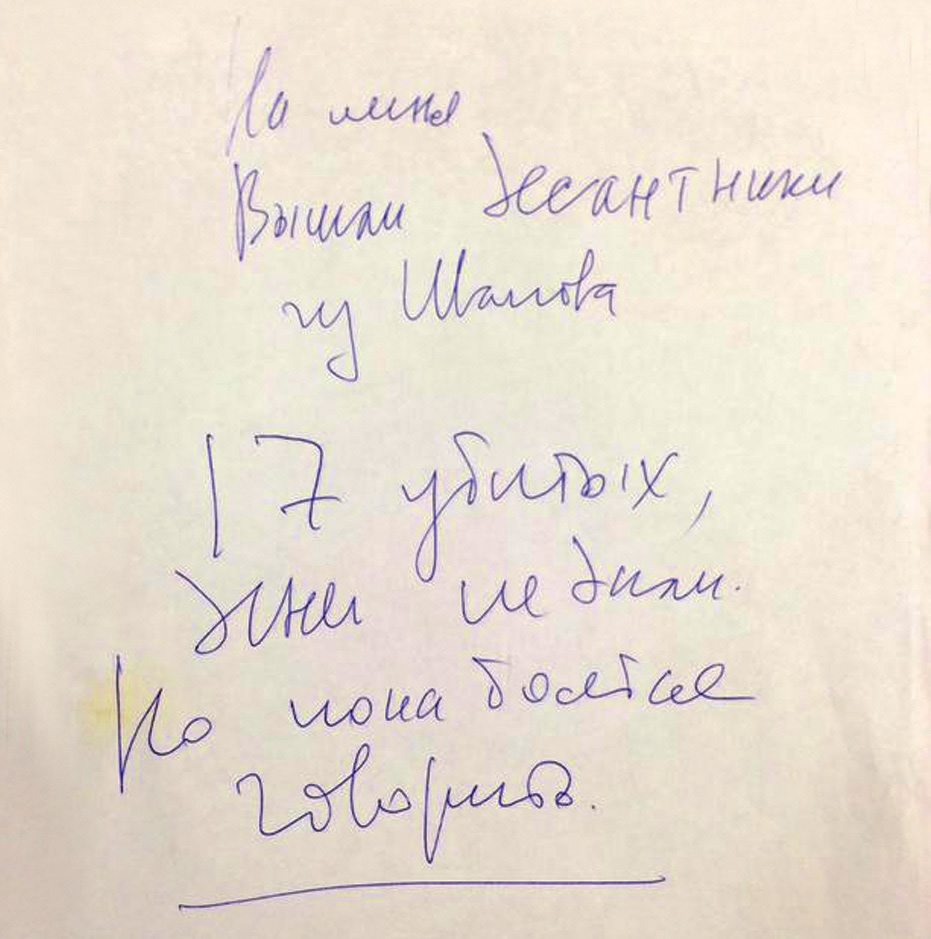 Note made by Boris Nemtsov not long before his murder. Text: “Paratroopers from Ivanovo got in touch with me. 17 killed. No cash. But for now are afraid to talk.”
Note made by Boris Nemtsov not long before his murder. Text: “Paratroopers from Ivanovo got in touch with me. 17 killed. No cash. But for now are afraid to talk.”
There has been some speculation that this one scrap was all there was from Nemtsov himself on this report. In fact, there was a scandal in the journalists’ community in Moscow recently when Lesya Ryabtseva, the assistant to Aleksei Venediktov, the editor-in-chief of Ekho Moskvy, wrote a pointed blog post questioning whether there was more to the Nemtsov report than the sticky.
This among other reasons of dissatisfaction caused Sergei Korzun, a founding editor, to resign from Ekho Moskvy, which has increasingly come under pressure from the government and is felt to be compromised by some of its readers.
Yet Ryabtseva’s claim overlooks Nemtsov’s work on the issues of the soldiers deployed in Ukraine months prior to his death, including his solicitation of testimony and his official inquiries to the FSB and Prosecutor General, as well as his own blog posts on issues such as Ramzan Kadyrov’s “personal army” — one of whose fighters, Zaur Dadayev was among the five Chechens later arrested and accused of his murder.
On May 30, 2014, Nemtsov sent an inquiry to Aleksandr Bortnikov, director of the Federal Security Service, regarding reports that a group of armed Chechens had crossed the border into Ukraine.
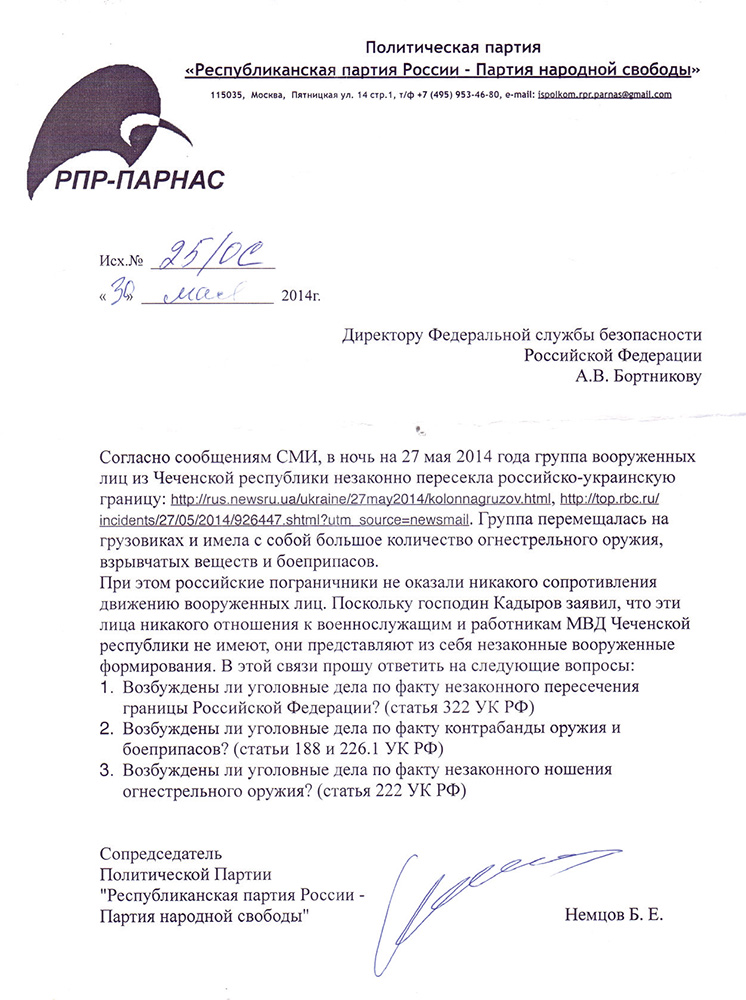
It would be unlawful to create an armed unit outside law-enforcement or the army and then participate in a foreign war — there is a Russian law against mercenary activity and illegal arms.
Here is a translation of his letter:
Political Party Republican Party of Russia – Popular Freedom Party 115035,
Moscow, Pyatnitskaya ul. 14 bldg. 1 tel. +7(495)-953-46-80 email: ispolkom.rpr.parnas@gmail.comRPR-PARNAS
No. 25/OC May 30, 2014
To: A.B. Bortnikov Director Federal Security Service Russian Federation
According to media reports, on the night of May 27, 2014, a group of armed
persons from the Chechen Republic illegally crossed the Russian-Ukrainian
border: The group was traveling in trucks and had with them a large quantity of
firearms, explosives, and ammunition.
Furthermore, Russian border guards did not display any resistance to the
movement of the armed persons. Since Mr. Kadyrov has stated that these persons
have no relationship to the servicemen and employees of the Interior Ministry
of the Chechen Republic, they represent unlawful armed formations. In that
connection, I ask you to answer the following questions:
1. Have criminal cases been opened regarding the fact of the unlawful
crossing of the border of the Russian Federation? (Art. 322 of the RF Criminal
Code) 2. Have criminal cases been opened regarding the fact of contraband
weapons and ammunition? (Art. 188 and Art. 226.1 of the RF Criminal Code). 3.
Have criminal cases been opened regarding the fact of unlawful bearing of
firearms? (Art. 222 of the RF Criminal Code).
Co-Chairman Political Party Republican Party of Russia – Popular Freedom
Party
As we noted, Nemtsov expressed his concern about Kadyrov’s “personal army” in a December 2014 post on Facebook. What was not known is that he also addressed a formal inquiry to the Prosecutor General’s Office on January 27, 2015, exactly a month before he was killed.
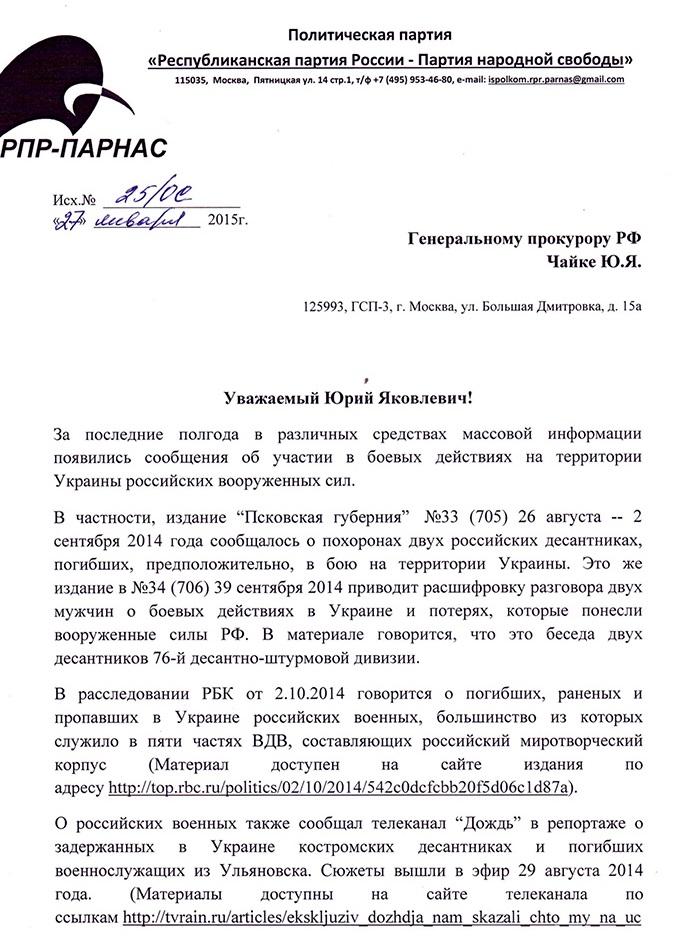
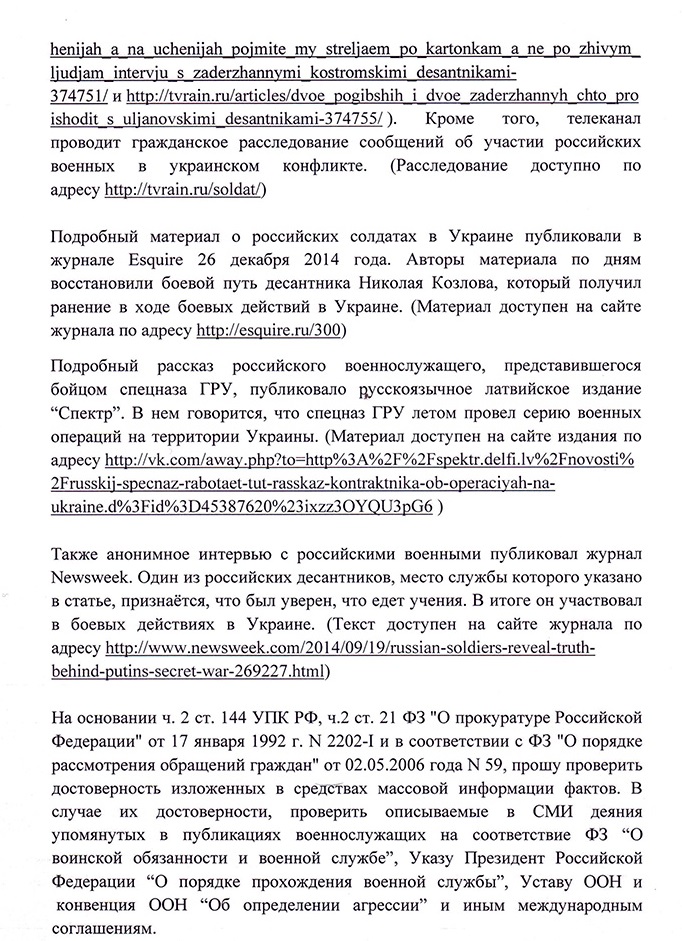
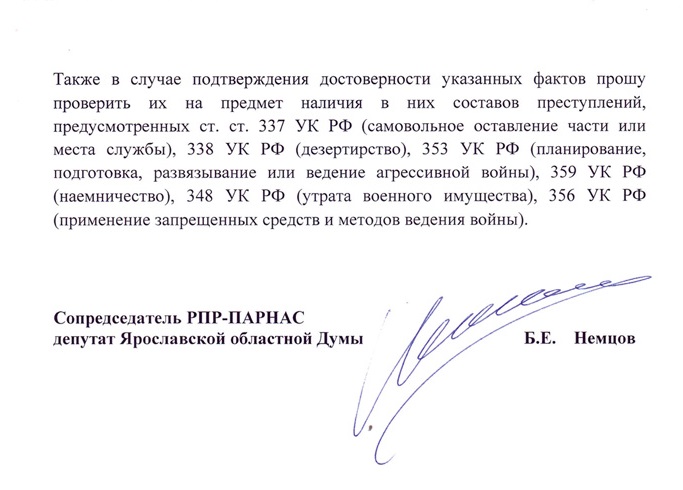
Political Party
Republican Party of Russia-Popular Freedom Party
115035, Moscow, Pyatnitskaya ul. 14 bldg.01
tel. +7(495)953-46-80
email: ispolkom.rpr.partnas@gmail.com
RPR-PARNAS
No. 25/OS
January 27, 2015
To:
Yu.Ya. Chaika
RF Prosecutor General
125993, GSP-3, Moscow
ul. Bolshaya Dmitrovka, d. 15aDear Yury Yakovlevich!
In the last six months, in various media, there have appeared reports about the participation in combat actions on the territory of Ukraine of Russian armed forces.
In particular, the publication Pskovskaya Guberniya No. 33 (705) of August 2 – September 2, 2014, there was a report about the funerals of two Russian paratroops who were killed apparently in battle on the territory of Ukraine. In the same publication in issue no. 34 (706) of September 29, 2014, the transcript of a conversation of two men about combat actions in Ukraine is cited, and the losses which were suffered by the RF armed forces. It is noted regarding the material that this conversation was of two paratroopers from the 76th Guards Assault Division.
In research by RBC from October 2, 2014, there is information about Russian military killed, wounded or missing in Ukraine, the majority of whom served in five units of the Airborne Troops consisting of the Russian peace-keeping corps. (Material is accessible on the site of the publication at this address.)
TV Rain also reported about the Russian military in a report about the Kostroma paratroopers detained in Ukraine and the servicemen from Ulyanovsk who were killed. The shows were broadcast on August 29, 2014. (Materials are accessible at the television channel’s site at this address: and this address.) Moreover, TV Rain conducted crowd research of the reports of participation of Russian military in the Ukrainian conflict. (The research is accessible at this address).
Detailed materials about Russian soldiers in Ukraine has been published in the journal Esquire on December 26, 2014. The authors of the materials reconstructed the day-by-day battle itinerary of the paratrooper Nikolai Kozlov, who was wounded during combat actions in Ukraine. (The material is accessible on the site of the magazine at this address).
A detailed account of a Russian serviceman who introduced himself as a GRU spetsnaz fighter was published in a Russian-language Latvian publication Spetkr. It describes how the GRU spetsnaz during the summer conducted a series of military operations on the territory of Ukraine. (The material is accessible on the site of the publication at this address.)
There was also an anonymous interview with Russian military published by the journal Newsweek. One of the Russian paratroopers whose place of service is indicated in the article admits that he was certain that he was going for training. In the end he took part in combat in Ukraine. (The text is accessible at the magazine’s web site at this address.)
On the grounds of Art. 144, part 2 of the RF Code of Criminal Procedures, Art. 21, part 2 of the Federal Law “On the Prosecutor’s Office of the Russian Federation” of January 17, 1922, no. N 2202-I and in accordance with the Federal Law “On the Procedure for Review of Citizens’ Appeals” of 02.05.2006 no. 59, I ask you to check the reliability of the facts outlined in the media. In the event of their accuracy, the activity described by the media of the servicemen mentioned in the publications for compliance with Federal Law “On Military Duty and Military Service,” the Decree of the President of the Russian Federation “On the Procedure for Military Service,” the UN Charter and the UN Convention “On the Definition of Aggression” and other international agreements.
Also in the event of confirmation of the authenticity of the facts indicated, I urge you to check them for evidence in them of crimes covered under Art. 337 of the RF Criminal Code (absence without leave from a base of place of service), Art. 338 of the RF Criminal Code (desertion), Art. 353 of the RF Criminal Code (planning, preparation or instigation of aggressive war), Art. 359 of the RF Criminal Code (mercenary activity), Art. 348 of the RF Criminal Code (waste of military property), and Art. 356 of the RF Criminal Code (use of forbidden means and methods of conducting war.).
Co-Chairman of RPR-PARNAS
Deputy of the Yaroslavl Regional Duma
B.E. Nemtsov
That date — January 27 — is the only indirect indication that Nemtsov’s persistent inquiries might have upset the Russian leadership enough to target him. As opposition leader Aleksei Navalny said, there may have been a meeting in the Kremlin where someone said that “something must be done” about Nemtsov to put a stop to his activity, and this could have been interpreted — and allowed — in an extreme form, assassination. They could have been a bureaucratic imperative to solve the problem within 30 days.
2. Estimates of Russian Federation Servicemen and Russian-Backed Militants in the Donbass and the Cost of the War
One section of the report likely to be controversial concerns the estimates of the number of Russians fighting in Ukraine, and local ethnic Russians or Russian speakers. This hasn’t been noticed before because it is somewhat buried in a later chapter of the report, number 9, “Who Rules the Donbass?” and another section in Chapter 11 about the estimates for the costs of the war for Russia.
From Chapter 9:
According to our estimates, the number of participants in combat in the east of Ukraine on the side of the separatists rose from 10,000-15,000 in the early summer of 2014 to 35,000 to 37,000 in the early spring of 2015; meanwhile the number of Russian Federation military rose from 3,000-5,000 to 8,000-10,000.
The spetsnaz Vladimir Yefimov, head of the Sverdlovsk Veterans’ Fund, who is involved in sending Russian [Federation] “volunteers” to Donbass published the costs for maintaining one Russian “volunteer”: 350,000 rubles per month (US $7,039). Multiply 350,000 rubles by 6,000 volunteers and for 10 months we get a figure of 21 billion rubles (US $422 million). Let us suppose that the monthly maintenance of the local “volunteers” costs three to four times less, we get a figure of 25 billion rubles ($498 million) for their maintenance for 10 months. Thus the total is 46 billion rubles ($920 million) for 10 months of the war or 4.6 billion rubles ($92 billion a month) of direct costs for the “volunteers.”
The report then goes on to estimate the total cost of the war:
Add to this 15% for the expenses for use, repair and service
of the military armor, for its transport from Russian Federation
warehouses — another 7 billion rubles ($132 million) Also it must be taken into
account that all the ammunition used by the separatists is intended for
outdated forms of weapons taken from warehouses and no longer produced
in Russia. In the same way, we estimate that all the Russian armor
destroyed or damaged in Donbass will not be restored by repairs or by
purchase of the RF Defense Ministry of additional units of military
armor.Thus, we have compiled the direct costs to Russia for the
war in the east of Ukraine for 10 months to be 53 billion rubles ($1
billion). On the one hand, that is not so much, if you take into account
that the annual expenditures of the Russian federal budget are 15
trillion rubles ($302 billion). But on the other hand, you can compare:
the cost of the state program “Development of Culture and Tourism” in
2015 was 95 billion rubles ($1.9 billion); the program “Preservation of
Nature” was 30 billion rubles ($604 million); the program “Development
of Physical Culture and Sports” is 68 billion ($1.3 billion); the
funding of two leading university of the country (Moscow and St.
Petersburg) within the framework of the program “Development of
Education” is a little more than 20 billion rubles ($402 million) a
year.
No one has attempted to estimate the costs of the war before — Nemtsov’s colleagues have said is at least $1 billion, which they
also point out is a fraction of Russia’s total state budget, yet still a
significant expenditure especially taking into account the economic
crisis and the ruble crash. This figure does not take into account the
cost of repairing all the damaged homes and office buildings and relocating displaced persons.
Not that from this calculation, the figure of about 28,000 local fighters can be deduced (and it was referenced earlier in Chapter 11) — there are many more of them than military from the Russian Federation, and they cost less to maintain, which is why the figure for their maintenance is higher. The Interpreter confirmed this with Sergei Aleksashenko, an economist who worked on the report.
This flies against conventional wisdom of some conflict-reporters that most of the fighters are Russian citizens sent into Ukraine. But we agree that there are numerous local fighters, including some in the political and military leadership, and it is important to concede this reality to understand the severity of the threat Ukraine and Europe is facing. It would be good if Nemtsov’s colleagues explained more about how they developed these figures.
An important reason to pay attention to these tens of thousands of militants is that regardless of the outcome of the Minsk peace talks and the prospect of continued support from Moscow, they remain armed and have installed authoritarian rule in the territories under their control. They will remain a problem, particularly because in the language of the Minsk agreements, the local so-called “militia” can remain in place, although this is the guise under which an entire army supplied by Russia perpetrated the war. In other world conflicts, there is usually a “DDR” process ( demobilization, disarmament, and reintegration); none is planned in the Donbass. This aspect of the war is not discussed, and the nature of the society resulting is not often reviewed due to the focus on the current armed conflict itself.
Here is some of the information gathered in the report about what life is like in the “People’s Republics”:
The hunger and drastic impoverization of the population of
the Donbass have also become realities. This was particularly acute in the
winter of 2014-2015. Yekaterina Sergatskova a journalist managed to gather
testimonies of deaths from hunger:
Sergei K., a volunteer and organizer of free cafeterias for
the poor who was recently forced to flee from Donetsk to liberated territories,
reported that 7 people died of hunger in Kirovskoye; in Snezhnoye, 5 people,
and in Krasny Partizansk in Lugansk Region, 68 people. According to
observations from locals, the bodies of those who have died are transported to
the city on sleds, because there aren’t any other means of transporting dead
bodies. Those who have died of dystrophia are recorded as having died of a
heart attack.
This is indirectly confirmed, in fact, by reports by Igor
Girkin (Strelkov), the former “DNR defense minister.” For example, he
writes: “In Donetsk and Lugansk Republics there is a lot of food. But the
old and disabled people (and not only they) don’t have any money at all to buy
it. Unfortunately, the authorities could care less about this, otherwise, they
would have long ago organized distribute of food by ration cards. It is
incomprehensible that people would die from hunger with the stores filled with
provisions. Today I was told that in Donetsk, the number of officially registered
deaths from dystrophy has exceed 20 persons. They say that in Lugansk Region,
things are no better.”
The authorities of the so-called DNR and LNR have not
managed to organize a fair distribution of humanitarian aid which is in acute
shortage. The separatist leaders themselves admit that a significant portion of
the cargo is stolen. For example, Arseny Pavlov (a Russian citizen whose
call-sign is “Motorola”), the famous commander of the fighters
announced in February 2015, that in distribution of humanitarian aid, “the
level of theft is off the scale.” “Humanitarian convoys are
arriving, but humanitarian aid is not reaching people,” he emphasized.
3. Documenting Kremlin Control of the Russian-Backed Separatists
The report also provides details of the Russian citizens who led the Russian-backed insurgence, describing the role of those known in the West such as propagandist Aleksandr Boroday, the prime minister of the self-declared “Donetsk People’s Republic”; (DNR); Col. Igor Strelkov (Girkin), for a time the DNR’s defense minister; Maj. Igor Bezler, who took over Gorlovka and has now disappeared; the notorious heroes of Russian state TV nightly war news “Givi” (Mikhail Tolstykh and “Motorola” (Arseny Pavlov) but also supplying more information on lesser known figures such as these:
Sergei Petrovsky
DNR intelligence
Russian citizen.Aleksandr Zhuchkovsky
National Democratic Party, St. Petersburg
Sputnik and Pogrom author
Most famous volunteer.
Delivers ammunition to the Strelkov Guard units
Russian citizenMarat Faatovich Bashirov
Tatar: Marat Foat ugly Bashirov
Chairman of LNR Council of Ministers
July 4 – August 20, 2014
Russian citizen
The authors of the report have also gone to the trouble to track down quotations from these figures that show their direct interaction with the Kremlin, and specifically the “grey cardinal” Vladislav Surkov. Aleksandr Boroday made this explicit in an interview:
“I can assure you that in the Russian leadership, they absolutely understand correctly how the problems of the DNR can be resolved and are prepared to enable this at the very highest level. I also have known and respected Vladislav Surkov, the aide to the president, who always provided the DNR with serious support. Without exaggeration, Surkov is our man in the Kremlin.”
The authors also brought to light this quote from Andrei Kolesnikov’s article in Kommersant on the day
following the Minsk talks which many had overlooked:
“It seemed a trivial matter remained: we had to get the
endorsement of the “Complex of Measures” from Aleksandr Zakharchenko
and Igor Plotnitsky, leaders of the DNR and LNR, who were waiting just for that
moment in the DipService Hall, where at that time the Contact Group was meeting. With that
person, Vladislav Surkov, aide to the president of Russia headed to the
DipService Hall. I saw how he came out of the negotiations room and headed to
the exit. At that moment it was still not clear where he was going, but it was
already clear that the events were beginning to unfold with growing speed…And
here the president of Ukraine came out of the negotiations room…He was very
dissatisfied with something. Later we learned why: Aleksandr Zakharchenko and
Igor Plotnitsky categorically refused to put their signatures under the
document. Aside from everything else, their signature could mean their
political (and not only political) death. But what can I say: all participants
in the process were taking risks with this document…It was the complete
collapse of the negotiations. Fourteen hours of time demonstratively wasted in
vein.
At 10:40 Vladimir Surkov returned from the Palace of
Independence and walked up to the third floor, where Vladimir Putin was located
at the time. In a little while, Francois Hollande and Angel Merkel also went
upstairs. They learned about the decision of the leaders of the militia
leaders…So what happened there on the third floor? I was able to reconstruct
these events. According to Kommersant’s information, Vladimir Putin told his
colleagues that they had to explain to Aleksandr Zakharchenko and Igor Plotnitsky
why they were wrong. “I will not pressure them,” he said several
times. But then what was all this? Angela Merkel proposed explaining everything
to the leaders of the DNR and LNR with reference to the meeting of the EU
Council of Ministers opening in Brussels. She said that the militiamen had to
be informed: they had one-and-a-half hours of time. No later than that would
the leaders of France and Germany leave and never return again, and no
negotiations would be possible at all. The Russian leader also had to confirm
this as well. So he confirmed it…Then they waited. Vladimir Putin went out
and once again came into the negotiations room, when two minutes were left
before the deadline of the ultimatum expired. He said that he had called
Vladimir Surkov and announced: ‘They have signed everything.'”
4. The Photographer of the Buk Launched to Down MH17
Another interesting section of the report is the re-publication of the work of Russian blogger Sergei Parkhomenko on MH17.
Nemtsov and his colleague Leonid Martyunuk had already released a video detailing the facts known about MH17 and supporting the theory that the Buk was shot down by the Russian-backed separatists.
In this report, they point out that both the Russian separatists and the Russia media, as we also pointed out, claimed they had shot down.
We additionally point out in our Evidence Review that the Russian media had reported the separatists’ bragging about their position of a Buk on July 14, before the downing of the MH17, when they downed a Ukrainian cargo plane.
The report points out that indirectly, Vitaly Churkin, Russia’s ambassador to the UN, admitted the responsibility of the separatists:
“People from the east (of Ukraine) said that they had shot down a military plane. If they believed that they had shot down a military plane, it was confusion. If it was confusion, then it was not an act of terrorism.”
DajeyPetros, the blogger at Ukraine@War was the first to work with this image, which he decided immediately was authentic.
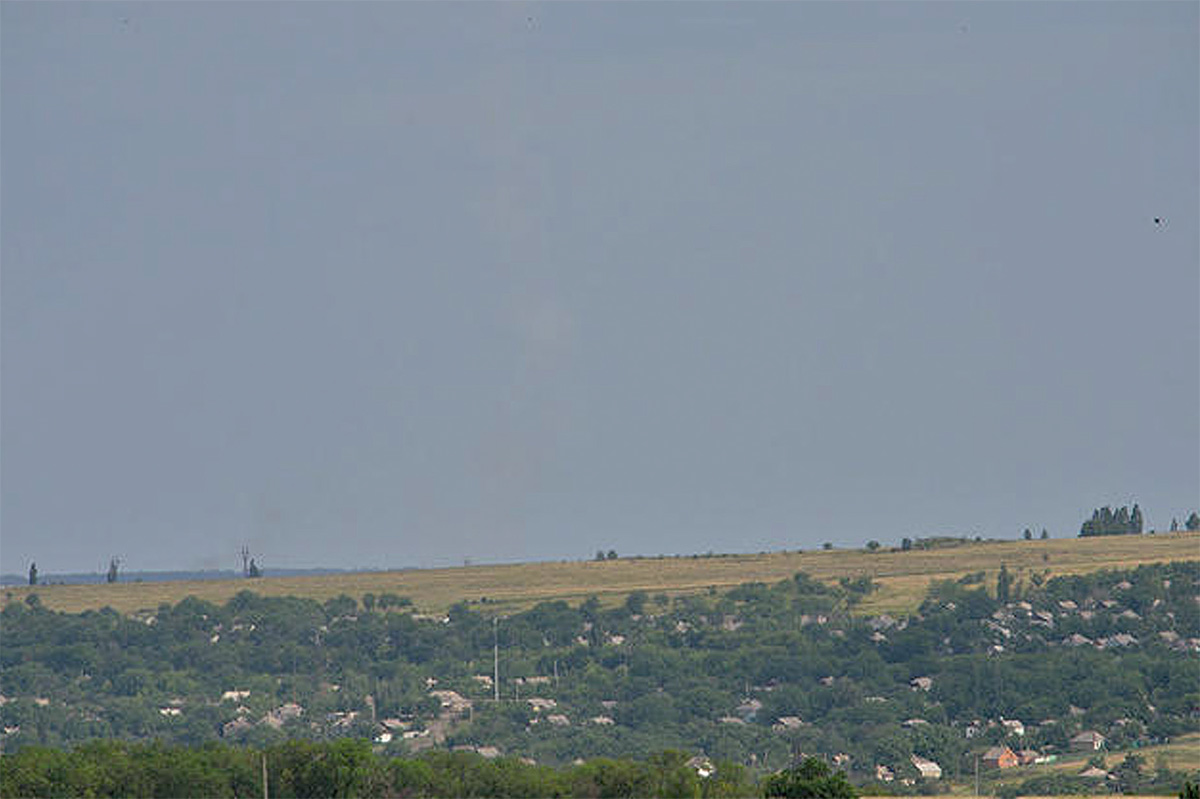
@DajeyPetros was able to geolocate the scene in the photo working with elements like the utility poles. He also explained why this scene was cloudless, while the area itself was reported as under cloud cover that day — it was taken from 20 km away.
He was also able to get some reporters to take a shot of what appeared to be the same scene and reconstruct the lines of sight, and also worked with a satellite image of a parked Buk; all of his research can be found here.
As we noted on July 23, both Buzzfeed and The Telegraph were able to get reporters into the field near Snezhnoye to examine the area and found scorched earth
In December 2014, Dutch photograph Olaf Koens found the man who had made the original photographs and interviewed him, as we reported, adding the translation from the Russian.
We also analyzed the first videos of the MH17 downing, including some found later by AP, Komsomolskaya Pravda, and Koens.
A translation into English of Koens’ article in RTL-nieuws was made by @DajeyPetros here.
This local photographer was fearful, operating in Russian-backed separatist territory, but he made his way to the Ukrainian Security Service (SBU) and gave them his camera and flash card, then turned them over to the Dutch investigators. The international researchers then talked with him extensively. He said to his knowledge there were no other photos taken of the Buk launching.
But not all his photos were published (there were just two published) and the Dutch interview doesn’t cover everything about his experience.
Thus it is significant that the Russian blogger Sergei Parkhomenko was able to reach the photographer by going through the pseudonymous Twitter account owner Khuyyovy Torez, a local person who had obtained a copy and uploaded it.

Translation: The witness took the photo at the moment of the missile launch. On the horizon is the cable-way between Lutugina and Tsof #torez border #Snezhnoye
Parkhomenko managed to find the author of the above-mentioned tweet, and through him, the photographer, and obtain the original shot from him.According to the report:
Upon examination of the jpg file (and further, the metadata of the NEF files in the RAW format) it becomes clear that there were no “spots” or “blots” on the image, as it seemed to suspicious sceptics. All of that “trash” came about from compressing the full-dimension files to a format needed for photographs to be uploaded to Twitter. The original of the photo is much brighter than the version which was published June 17, 2014. It was “darkened” before publication on Twitter in order to make the streak of smoke in the middle of the scene more visible.
Sergei Parkhomenko reported the following about the circumstances of the shooting by the author of the photograph:
“During the day, while I was in my own apartment in a building on the outskirts of Torez, I heard thunder, much stronger than the customary sounds of artillery firing, mortar explosions or the volleys of a Grad. I ran to the window and saw that the wind was slowing erasing a smoke trail over the horizon. The photo camera lay on the windowsill. I grabbed it and raced up the stairs to the roof in order to take the picture from there. I clicked the first time. I saw that directly across the scene were stretched electrical wires. I twisted the zoom to the maximum and took a second photo. then I turned and saw that from the other direction, in the north (that is, right in the direction of Grabov) there was a column of thick black-blue smoke. I decided that a missile had launched on some gas station or oil tank. I crawled to the other side of the roof in order to take a picture from there, where the wires and antennas didn’t get in the way. I crawled over for about three minutes — then made the third shot. I didn’t guess that in the third shot there was smoke from the plane that had just fell: I didn’t see any plane. Therefore I didn’t start shooting further: if I knew what event had been captured in the frame, I would have taken some more, of course. but I only learned a few hours later exactly what had happened. I then sent the pictures to a friend, and he uploaded them to Twitter.”
In the system information contained in the photo sent by the author of the NEF files, there really was all the necessary information about the camera used: its settings and expositions and also the time of the shooting of these scenes: Photo 1 – 2014-07-17 16:25:41.50; Photo 2 — 2014-07-17 16:25:48.30; Photo 2 — 2014-07-17 16:30:06.50. This is in six and then ten minutes, respectively after the time which was considered officially to be the moment of the crash of the Boeing MH17.
The pictures sent by the photographer contain sufficient detail also to reliably tie the position of the picture to a real location. In the first photo, indicating a wider angle of view, numerous such details can be distinguished.
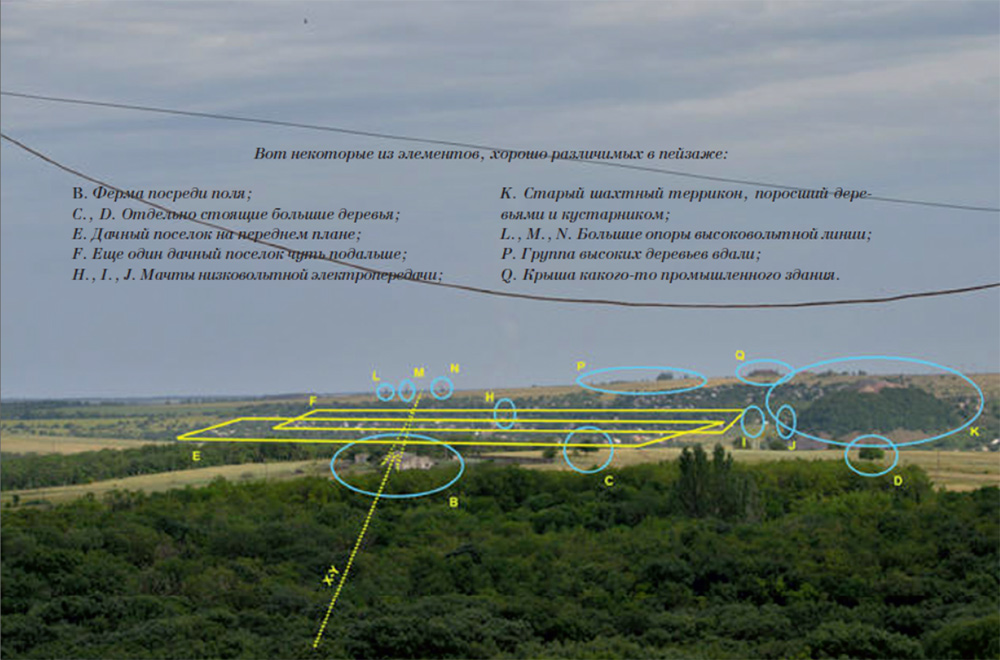
He listed some of the elements which are well-distinguished in the landscape — having access to a local person, he was able to know what to look for in the picture.
B. A farm in the middle of a field.
C, D. Large trees standing alone.
#. A dacha village in the foreground.
F. Another dacha village somewhat further;
H., I., J. Low-voltage electrical transmission towers
K. Old coal mine slag-heap overgrown with trees and bushes.
L., M., N. Large high-voltage line poles.
P. Group of talk trees in the distance.
Q. Roof of some industrial building.
In an enlargement presenting a larger plane, several of the landmarks have been captured that are noted in the first photograph, and here they can be viewed more clearly:
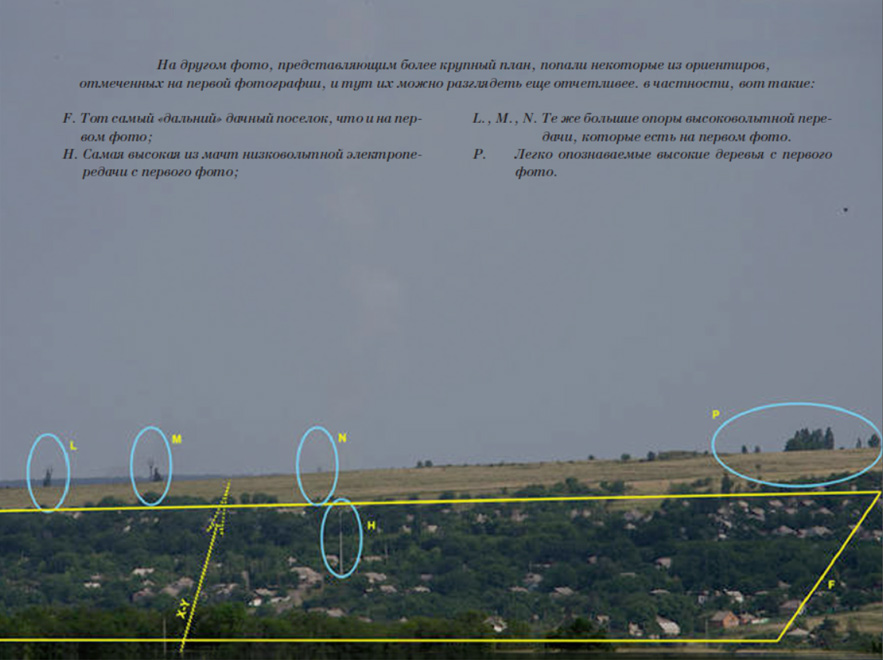
He added this notation:
F. The very “further” dacha village which was in the first photo.
H. The highest of the low-voltage electrical transition towers from the first photo.
L., M., N. The same large poles of the high-voltage transmissions which are in the first photo.
P. Easily-recognized tall trees from the first photo.
He then added:
The next step of analysis is the attempt to identify these characteristic details in the “top-down view,” that is on the pictures from the satellite photos. There are a fair number of such shots in our possession, and they are made in a very good, detailed resolution and available in particular to users of the program Google Earth.
Here is a section of the satellite photo on which all the landmarks noted in the two photographs are well visible.

Point A here is marked as the starting position of the author of the photograph indicated by himself. And really, on the satellite image you can find everything that was caught by the lens: the farm, the separate trees ,the two dacha villages, the line of high and low voltage electrical transmission towers, the well-identified slag-heap) (all the landmarks are marked here by the same letters as on the starting position photographs). This proves that the author of the photograph precisely indicated his location.
Thus the possibility appears to trace the imaginary “view axis” along which the black smoke was seen by the photographer which rose above the presumed starting point and was gradually carried by the wind to the right. In the photographs we see it approximately in the direction of the middle high-voltage electrical tower — what we have indicated her with the letter M. This line (X-Y) can be traced on a satellite map: from the point where the photograph was taken across the tall utility pole. For comparison, it is marked also on the photographs with the marked landmarks. The logical conclusion: it is on this axis or right next to it that the location from which the missile was fired which downed MH17.
With a large degree of likelihood, the Buk system which fired the fateful shot was located in this area.
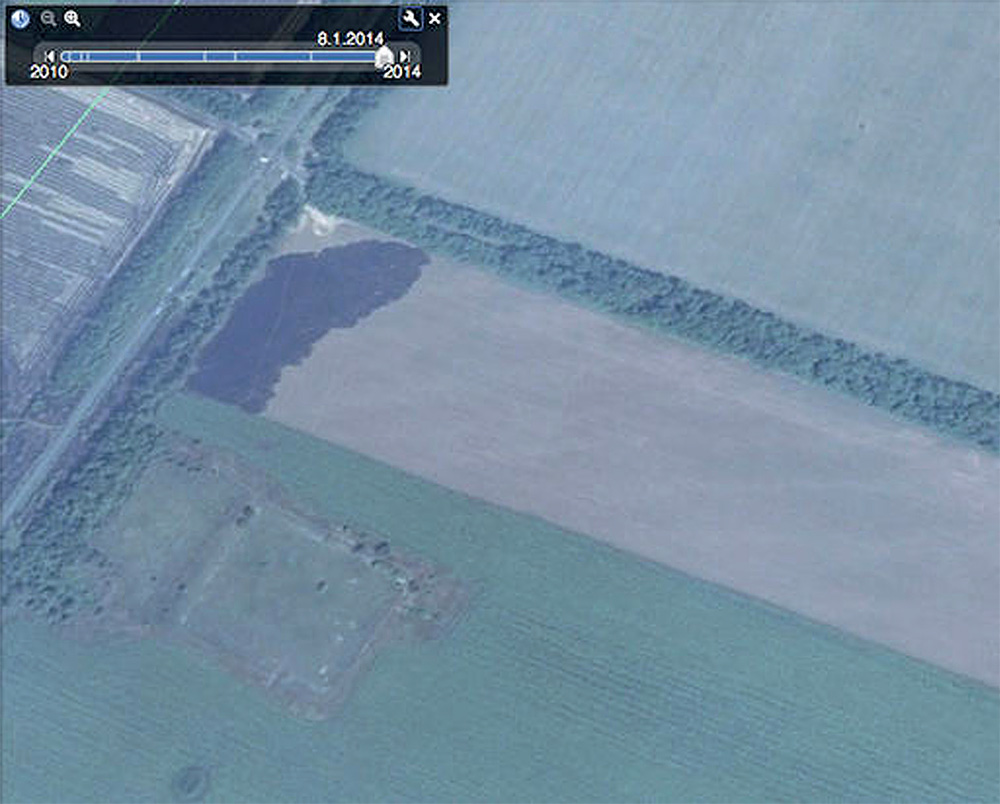
This is an elongated field near the road. At the left edge is the well-marked traces from the maneuvers of some heavy armor and next to it a large piece of burnt, black earth, partly already plowed. Such a position is convenient for the placement of a missile system: right across the road is an entrance through a narrow but thick woods which hides the field from outside eyes. And one more detail: the road leads to the village of Snezhnoye, where in July 2014, the Buk system was photographed multiple times and recorded on a video.
This dovetails with the work of @DajeyPetros and Olaf Koens and is an important contribution of more detail and a further report from the photographer.
All in all, Nemtsov’s colleagues have pulled together the main known sources and some lesser known or unknown until now, proving Putin’s complicity in the war in Ukraine, and the terrible toll this has taken on the Ukrainian people and the Russian people as well. The study is an important educational tool for the domestic Russian audience for which it was intended, and will also be a good summary for Westerners of what the opposition accomplished in attempting to bring their government to account.
As the assassination of Nemtsov starkly indicates, however, along with the suspicious poisoning of Vladimir Kara-Murza, his colleague, and the interrogation and searches of other opposition figures such as Natalya Pelevina, this work is vulnerable to attack and even extinction. Today, Putin issued a decree making it a crime to publicize information about the deaths in combat of military personnel — directly timed to the release of the report.